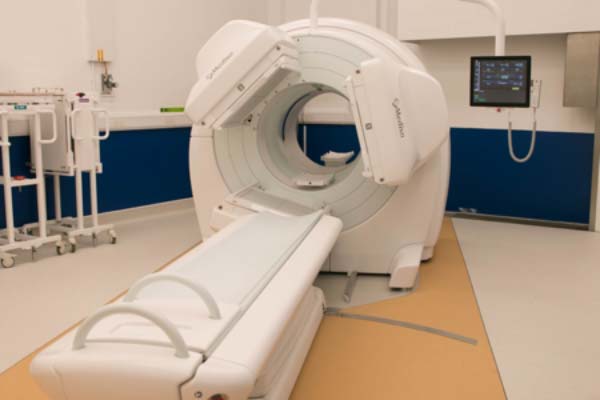Radionuclides play a key role in medicine due to the ability to obtain images of physiological function, providing vital diagnostic tools for oncology, dementia, neurology, cardiology and external beam radiotherapy planning. Beta and alpha emitting radionuclides are used in molecular radiotherapy (MRT) to selectively treat malignant tissue whilst minimising the radiation to healthy organs. Around 1 million patients a year undergo a nuclear medicine procedure in the UK to diagnose, monitor, or provide therapy for a range of diseases.
Traceability to primary standards of radioactivity underpins all clinical administrations of radio-pharmaceuticals. To achieve successful outcomes, both the administered activity and the absorbed doses delivered to target (and healthy) organs should be known as accurately as possible. The need for new primary and secondary standards of activity for emerging radionuclides, an area in which NPL has a world-leading reputation, is predicted to increase significantly with expanding interest in theranostic isotopes and increased use of alpha emitter therapy.
We are focused on providing metrology for current and future use of nuclear medicine in the clinic, supported by new world-leading nuclear medicine imaging standards and research capabilities. Our work is focused on the following key areas.
We have a world-leading reputation in nuclear metrology, providing primary standards of radioactivity for emerging radionuclides and supporting their transfer to the clinic. With a variety of techniques available NPL can provide primary standards for existing and novel radionuclides, as well as provide measurement advice for sites using radionuclide calibrators and ionisation chambers. NPL can also offer radiochemistry research or advice for novel matrices or pharmaceuticals and performs nuclear data measurements to support research and Monte Carlo applications.
We offer a range of services to clinical sites using radionuclide calibrators including the calibration of medical radionuclides, supply of calibration sources or testing of the secondary standard radionuclide calibrator known as the Fidelis. NPL can also offer advice and a dedicated eLearning course to enable users to get the most out of their radionuclide calibrator measurements in line with NPL Good Practice Guide 93.
SPECT and PET imaging are some of the most powerful clinical techniques for diagnosing, assessing treatment response, staging and re-staging of different types of cancer in patients. Current clinical SPECT systems do not provide quantitative imaging (converting detected counts within an image voxel to an activity) which is traceable to a primary standard. In the case of PET imaging whilst the development of quantitative corrections to PET images is more advanced than for SPECT, the relatively short half-lives of the majority of PET radionuclides means that ensuring traceability to primary standards is a unique challenge.

Mediso AnyScan SCP (SPECT-CT-PET) system in the NPL nuclear medicine imaging laboratory
Our research in metrology for quantitative nuclear medicine imaging at NPL is centred around our Mediso AnyScan SCP (SPECT-CT-PET) system housed in a dedicated nuclear medicine imaging laboratory. This unique facility is working to develop a full uncertainty budget for traceable quantitative imaging and to establish the world’s first secondary standard for quantitative SPECT. This work is supported by our expertise in Monte Carlo simulation of SPECT imaging systems.
This work is supported by a dedicated rapid phantom prototyping laboratory. This facility is focused on the use of rapid prototyping (3D printing) to produce bespoke patient-representative models for imaging research. This includes the production of novel tissue equivalent 3D printable materials.
We are working on improving qualitative and quantitative diagnostic Nuclear Medicine Imaging for SPECT/CT and PET/CT using standard and cutting-edge reconstruction algorithms. We use, and study iterative algorithms base on maximum likelihood expectation maximisation (MLEM) as well as the filtered back-projection algorithm (FBP). Driven by the willingness of providing image reconstruction reproducibility, we are working on providing open source image reconstruction capabilities for SPECT imaging using the Software for Tomographic Image Reconstruction (STIR), which already provide extended functionalities for PET reconstruction and image processing.
In contrast to external beam radiotherapy or brachytherapy, activity administrations in molecular radiotherapy are not guided by dosimetry, despite the introduction of the new Ionising Radiations Regulations 2017 following EU directive 2013/59/EURATOM. Dosimetry is still an emerging field in nuclear medicine which requires standardisation and harmonisation.
We use and develop a range of internal dosimetry calculation methods for nuclear medicine and molecular imaging applications, including radiation transport Monte Carlo simulations in combination with SPECT/CT or PET/CT images. We provide dosimetry support for routine diagnostic and therapeutic clinical nuclear medicine procedures, as well as clinical trials by performing patient-specific dosimetry, uncertainty evaluation and radiobiological modelling. We can also support pre-clinical studies and therefore accelerate the translation of novel radiotracers into clinical practice.
The group has extensive experience leading international collaborations on dosimetry for molecular radiotherapy (MRT), including the EMRP MetroMRT and on-going EMPIR MRTDosimetry projects. These bring together expertise in measurement science and nuclear medicine from academia, hospitals and industry to prove the metrology needed for the clinical implementation of dosimetry in radiotherapy.
We are also active members of the Internal Dosimetry Users Group (IDUG); a scientific community promoting the use of dosimetry in MRT in the UK by providing an open forum for discussion and sharing best practices on dosimetry, hosting scientific meeting and dosimetry training and issuing guidelines for its implementation.
Our research and measurement solutions support innovation and product development. We work with companies to deliver business advantage and commercial success.
Contact our Customer Services team on +44 20 8943 7070